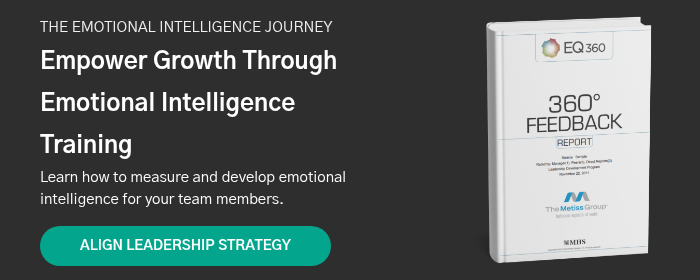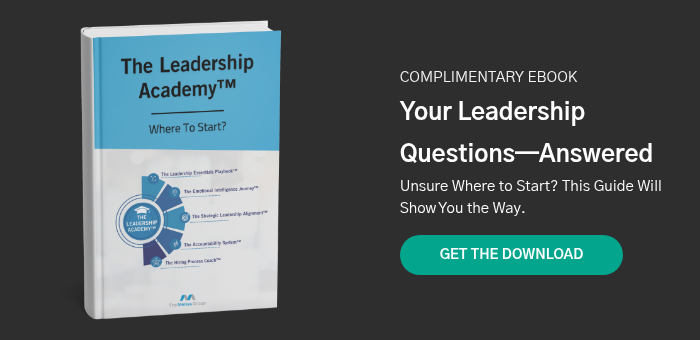Where Should Senior Leaders Begin Their Leadership Development?
July 23rd, 2025
3 min read
By Cyndi Gave

Many organizations mistakenly assume that senior leaders no longer need leadership development. Titles, tenure, and years of experience are often treated as proof of leadership mastery. But in reality, many senior leaders reach executive roles without ever developing foundational leadership behaviors, emotional intelligence, or strategic agility—leaving performance gaps that quietly stall progress and culture.
Having worked closely with executives across diverse industries, we’ve seen the stark difference between leaders who have intentionally developed their capabilities and those who have simply risen through technical or operational excellence. Here at the Metiss Group, we specialize in leadership diagnostics and tailored programs that meet leaders where they are—whether they need to build foundational skills, align leadership with strategy, or develop high-functioning Visionary-Integrator dynamics.
In this article, you will learn:
- How Leadership Maturity and Learning History Determine Development Entry Points
- Why Emotional Intelligence in the Workplace is Foundational for Senior Leaders
- When Leadership Training Programs Drive Department-wide Performance Gains
- How to Align Leadership Practices With Strategic Business Priorities
- What to Consider When Pairing Visionaries and Integrators for Executive Growth

How Leadership Maturity and Learning History Determine Development Entry Points
Not all senior leaders arrive at their roles with the same leadership foundation. Those who have actively sought feedback, reflected on interpersonal dynamics, and studied leadership theory tend to have a stronger base. These individuals, regardless of age, are often ready for more advanced strategic leadership programs such as The Strategic Leadership Alignment™. We designed this program for those seeking to recalibrate leadership practices with organizational goals, particularly when growth has plateaued or strategic execution is misaligned.
Conversely, some senior leaders have never participated in formal leadership development. They may have risen through operational excellence or organizational loyalty. Their leadership style may remain intuitive and reactive rather than intentional and scalable. These individuals often benefit from The Leadership Essentials Playbook™, which introduces the eight core practices we’ve proven to elevate individual and team performance. The program provides a structured environment to build foundational leadership capabilities and encourages consistent application across departments.
Why Emotional Intelligence in the Workplace is Foundational for Senior Leaders
Among the most underestimated attributes in leadership is emotional intelligence. As leaders advance, technical skills and business acumen become less differentiating. What often determines success is how effectively leaders communicate, manage conflict, and respond under pressure. The Emotional Intelligence Journey™ addresses these areas directly, offering senior leaders a path to better self-awareness, clearer communication, and improved relational judgment.
For those who find themselves misinterpreted, impatient in meetings, or challenged by interpersonal conflict, this course offers more than theory. It enables behavioral shifts that influence organizational culture, employee performance, and retention. Emotional intelligence in leadership is not just a soft skill. It is a strategic lever.
When Leadership Training Programs Drive Department-wide Performance Gains
Leadership development is most powerful when practiced across teams, not in isolation. The Leadership Essentials Playbook™ was designed with this scalability in mind. When multiple leaders adopt shared leadership practices, the impact becomes systemic. Performance standards align. Communication norms stabilize. Teams transition between departments with fewer disruptions.
The benefits compound as consistency replaces variability. Leadership styles may still vary, but the expectations for coaching, feedback, and decision-making become clearer. For organizations seeking a culture of performance, leadership training programs like this are not optional. They are operational necessities.

How to Align Leadership Practices With Strategic Business Priorities
Strategic stagnation is rarely a result of poor planning. More often, it reflects a misalignment between current leadership behaviors and the evolving demands of the business. The Strategic Leadership Alignment™ helps senior leaders bridge this gap.
When organizations that have been experiencing aggressive growth need to stabilize with processes and systems, the leadership practices which created the successful growth could be an actual detriment to the stabilizing phase. Similarly, an organization which has been stable for years but strives to take on more market share or introduce new products, could be hampered by the leadership practices that served them well previously.
Once the strategic plan is aligned to a leadership development strategy, integrating feedback from peers, supervisors, and direct reports, can surface discrepancies between intention and perception.
This 360-degree perspective fosters accountability and sharpens focus. Leaders are equipped to shift their behaviors to support strategic execution, whether it involves scaling operations, reinforcing processes, or managing post-growth stabilization. The program builds strategic agility into leadership practice, a necessity in competitive markets.
What to Consider When Pairing Visionaries and Integrators for Executive Growth
Founders and senior executives often carry dual responsibilities: driving the vision and managing execution. Over time, this duality becomes unsustainable. The Visionary-Integrator Catalyst™ is tailored for this challenge. It helps organizations identify, onboard, and develop Integrators who can complement the Visionary’s strengths while mitigating their blind spots.
This dynamic is especially relevant in entrepreneurial or EOS-run organizations, where role clarity and execution discipline are vital. The program addresses one of the most common reasons for Integrator failure: lack of role alignment and Visionary overreach. By clarifying expectations before hiring and providing structured development afterward, both Visionary and Integrator grow together in real time.
Takeaways
Leadership development for senior leaders cannot be prescriptive. It must begin with honest assessment, aligned with strategic goals, and be supported by development programs that recognize where each leader stands. Whether the goal is strengthening emotional intelligence, standardizing leadership practices, or bridging execution gaps, the right starting point exists within a framework like The Leadership Academy™. When approached thoughtfully, leadership development becomes more than a corrective measure. It becomes a strategic advantage.
Topics:


